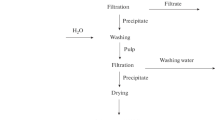Abstract
The feasibility of synthesizing gadolinium tantalum niobates by the liquid-phase method was demonstrated. The methods of X-ray diffraction, electron probe microanalysis, local cathodoluminescence, and photoluminescence were applied to study the samples. It was shown that under the selected synthesis conditions (T ~ 1400°C for 3 hours), no solid solution of niobium-tantalum was formed in the powder samples. When obtaining ceramic samples, it was possible to obtain a solid solution and to study the dependence of the luminescence intensity on the niobium content upon excitation of the samples by an electron beam. The maximum luminescence intensity was observed in the sample with the composition of GdNb0.9Ta0.1O4. It was shown that the inhomogeneity of luminescence is not related to fluctuations in composition, but is related to the inhomogeneous distribution of vacancy centers, which are luminescence centers.






Similar content being viewed by others
REFERENCES
M. Nikl, Meas. Sci. Technol. 17, R37 (2006).
T. Yanagida, Proc. Jpn. Acad. B 94, 75 (2018).
S. Tavernier, A. Gektin, B. Grinyov, and W. W. Moses, Radiation Detectors for Medical Applications (Springer Science, New York, 2006).
M. Globus, B. Grinov, and J. K. Kim, Inorganic Scintillators for Modern and Traditional Applications (Inst. Monokristallov, Kharkov, 2005), p. 583 [in Ukrainian].
M. Nikl and A. Yoshikawa, Adv. Opt. Mater. 3, 463 (2015).
P. Dorenbos, Nucl. Instrum. Methods Phys. Res., Sect. A 486, 208 (2002).
C. R. Stanek, K. J. McClellan, M. R. Levy, and R. W. Grimes, J. Appl. Phys. 99, 113518 (2006).
M. Nikl, A. Yoshikawa, A. Vedda, and T. Fukuda, J. Cryst. Growth 292, 416 (2006).
M. V. Nazarov, D. Y. Jeon, J. H. Kang, E. Popovici, L. E. Muresan, M. V. Zamoryanskaya, and B. S. Tsukerblat, Solid State Commun. 131, 307 (2004).
V. Vishwnath, M. Srinivas, N. Patel, D. Modi, and K. V. R. Murthy, AIP Conf. Proc. 1731, 110019 (2016).
I. Arellano, M. Nazarov, C. C. Byeon, E.-J. Popovici, H. Kim, H. C. Kang, and D. Y. Noh, Mater. Chem. Phys. 119, 48 (2010).
X. Wang, X. Li, H. Zhong, S. Xu, L. Cheng, J. Sun, J. Zhang, L. Li, and B. Chen, Sci. Rep. 8, 5736 (2018).
Y. Lü, C. Chen, S. Li, X. Liu, L. Yan, Y. Dai, A. Zhang, Y. Xie, and X. Tang, Eur. J. Inorg. Chem. 31, 5262 (2015).
X. Liu, Y. Lü, C. Chen, S. Luo, Y. Zeng, X. Zhang, M. Shang, C. Li, and J. Lin, J. Phys. Chem. C 118, 27516 (2014).
O. Voloshyna, I. Boiaryntseva, D. Spassky, and O. Sidletskiy, Solid State Phenom. 230, 172 (2015).
O. Voloshyna, O. Sidletskiy, D. Spassky, I. Gerasymov, I. Romet, and A. Belsky, Opt. Mater. 76, 382 (2018).
S. M. Masloboeva, G. N. Duboshin, and L. G. Arutyunyan, Vestn. Mosk. Tekh. Univ. 12, 279 (2009).
M. V. Zamoryanskaya, S. G. Konnikov, and A. N. Zamoryanskii, Instrum. Exp. Tech. 47, 477 (2004).
ACKNOWLEDGMENTS
XRD and structural studies were performed using the equipment of the Joint Research Center “Material science and characterization in advanced technology.” Authors are also grateful to the Center for the Collective Use of Physical Methods of Investigation.
Author information
Authors and Affiliations
Corresponding author
Ethics declarations
The authors declare that they have no conflict of interest.
Rights and permissions
About this article
Cite this article
Ivanova, E.V., Masloboeva, S.M., Kravets, V.A. et al. Synthesis and Luminescent Properties of Gadolinium Tantalum Niobates Gd(NbxTa1 – x)O4. Opt. Spectrosc. 127, 1011–1017 (2019). https://doi.org/10.1134/S0030400X19120348
Received:
Revised:
Accepted:
Published:
Issue Date:
DOI: https://doi.org/10.1134/S0030400X19120348




